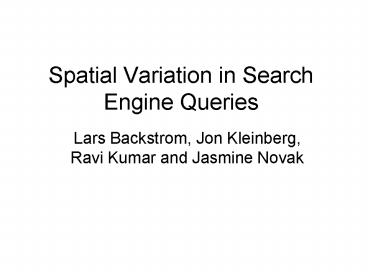Spatial Variation in Search Engine Queries PowerPoint PPT Presentation
Title: Spatial Variation in Search Engine Queries
1
Spatial Variation in Search Engine Queries
- Lars Backstrom, Jon Kleinberg, Ravi Kumar and
Jasmine Novak
2
Introduction
- Information is becoming increasingly geographic
as it becomes easier to geotag all forms of data. - What sorts of questions can we answer with this
geographic data? - Query logs as case study here
- Data is noisy. Is there enough signal? How can
we extract it. - Simple methods arent quite good enough, we need
a model of the data.
3
Introduction
- Many topics have geographic focus
- Sports, airlines, utility companies, attractions
- Our goal is to identify and characterize these
topics - Find the center of geographic focus for a topic
- Determine if a topic is tightly concentrated or
spread diffusely geographically - Use Yahoo! query logs to do this
- Geolocation of queries based on IP address
4
Red Sox
5
Bell South
6
Comcast.com
7
Grand Canyon National Park
8
Outline
- Probabilistic, generative model of queries
- Results and evaluation
- Adding temporal information to the model
- Modeling more complex geographic query patterns
- Extracting the most distinctive queries from a
location
9
Probabilistic Model
- Consider some query term t
- e.g. red sox
- For each location x, a query coming from x has
probability px of containing t - Our basic model focuses on term with a center
hot-spot cell z. - Probability highest at z
- px is a decreasing function of x-z
- We pick a simple family of functions
- A query coming from x at a distance d from the
terms center has probability px C d-a - Ranges from non-local (a 0) to extremely local
(large a)
10
Algorithm
- Maximum likelihood approach allows us to evaluate
a choice of center, C and a - Simple algorithm finds parameters which maximize
likelihood - For a given center, likelihood is unimodal and
simple search algorithms find optimal C and a - Consider all centers on a course mesh, optimize
C and a for each center - Find best center, consider finer mesh
11
a 1.257
12
a 0.931
13
a 0.690
14
Comcast.com a 0.24
15
More Results (newspapers)
Newspaper a
The Wall Street Journal 0.11327
USA Today 0.263173
The New York Times 0.304889
New York Post 0.459145
The Daily News 0.601810
Washington Post 0.719161
Chicago Sun Times 1.165482
The Boston Globe 1.171179
The Arizona Republic 1.284957
Dallas Morning News 1.286526
Houston Chronicle 1.289576
Star Tribune (Minneapolis) 1.337356
- Term centers land correctly
- Small a indicates nationwide appeal
- Large a indicates local paper
16
More Results
School a
Harvard 0.386832
Caltech 0.423631
Columbia 0.441880
MIT 0.457628
Princeton 0.497590
Yale 0.514267
Cornell 0.558996
Stanford 0.627069
U. Penn 0.729556
Duke 0.741114
U. Chicago 1.097012
City a
New York 0.396527
Chicago 0.528589
Phoenix 0.551841
Dallas 0.588299
Houston 0.608562
Los Angeles 0.615746
San Antonio 0.763223
Philadelphia 0.783850
Detroit 0.786158
San Jose 0.850962
17
Evaluation
- Consider terms with natural correct centers
- Baseball teams
- Large US Cities
- We compare with three other ways to find center
- Center of gravity
- Median
- High Frequency cell
- Compute baseline rate from all queries
- Compute likelihood of observations at
each0.1x0.1 grid cell - Pick cell with lowest likelihood of being from
baseline model
18
Baseball Teams and Cities
- Our algorithm outperforms mean and median
- Simpler likelihood method does better on baseball
teams - Our model must fit all nationwide data
- Makes it less exact for short distances
19
Temporal Extension
- We observe that the locality of some queries
changes over time - Query centers may move
- Query dispersion may change (usually becoming
less local) - We examine a sequence of 24 hour time slices,
offset at one hour from each other - 24 hours gives us enough data
- Mitigates diurnal variation, as each slice
contains all 24 hours
20
Hurricane Dean
- Biggest hurricaneof 2007
- Computed optimalparameters for each time slice
- Added smoothing term
- Cost of moving from A to B in consecutive time
slices?A-B2 - Center tracks hurricane, alpha decreases as storm
hits nationwide news
21
(No Transcript)
22
Multiple Centers
- Not all queries fit the one-center model
- Washington may mean the city of the state
- Cardinals might mean the football team, the
baseball team, or the bird - Airlines have multiple hubs
- We extend our algorithm to locate multiple
centers, each with its own C and a - Locations use the highest probability from any
center - To optimize
- Start with K random centers, optimize with
1-center algorithm - Assign each point to the center giving it highest
probability - Re-optimize each center for only the points
assigned to it
23
United Airlines
24
Spheres of influence
25
Spheres of Influence
- Each baseballteam assigneda color
- A team with Nqueries in a cellgets NC votes
for its color - Map generated be taking weighted average of colors
26
Distinctive Queries
- For each term and location
- Find baseline rate p ofterm over entire map
- Location has t totalqueries, s of them withterm
- Probability given baseline rate isps(1-p)t-s
- For each location, we find the highest deviation
from the baseline rate, as measured by the
baseline probability
27
(No Transcript)
28
Conclusions and Future Work
- Large-scale query log data, combined with IP
location contains a wealth of geo-information - Combining geographic with temporal
- Spread of ideas
- Long-term trends
- Using spatial data to learn more about regions
- i.e. urban vs. rural

